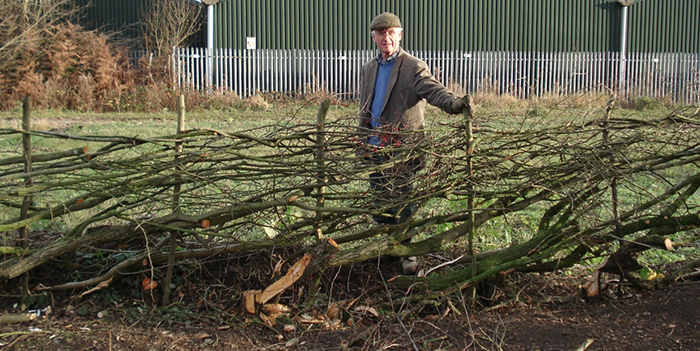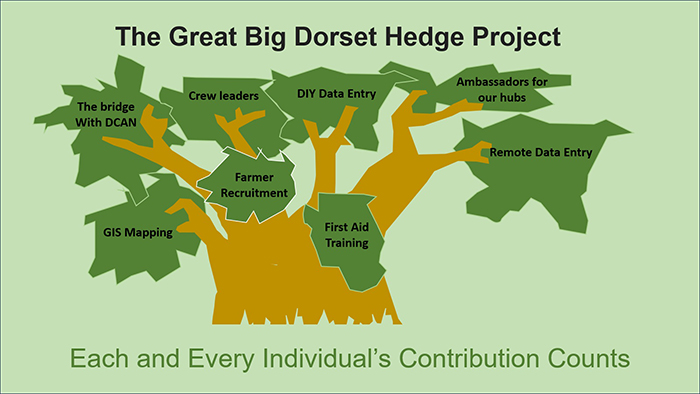Great Big Dorset Hedge Day**
Traveller’s Rest Farm
May 15th 2025
Ancient Crafts: A Modern Approach to Nature & Conservation by George Darvall
Pre-WW1 coppiced woodland was widespread – stands of oak with an under-storey of coppiced hazel. The hazel was coppiced every 7 years as it was valued & used in thatching, hurdles & walking sticks. Foresters would manage one coupe (compartment of the woodland) per year. The oak was particularly used in ship-building, with the best saplings kept & the rest thinned out. This was commercial forestry, where no-one thought of the wildlife, which was either tolerated or persecuted.
However, these woods were actually good for wildlife, providing a stable environment, with a mixture of species such as nightingales & the brown fritillary butterfly & the glades full of wild flowers.
The decline of the hazel coppice came after the Great War, with sheep farming practice requiring less hurdles; recession employing less men & WW11 sending men off to war. Conifer plantations took over in many places, providing telephone poles & pit props for coal mines. Woods were cut down to make way for housing estates.
Some conservation organisations began to come to the rescue of ancient woodlands, purchasing nature reserves & managing woods with the help of volunteers or paid contractors.
The Rothschild Report on Science & Technology helped to produce a White Paper in the mid-1970s, stating that scientists had a duty to benefit the nation & so why could conservation not pay? George Darvall wrote an article published in the Sunday Times in June 1977 on the importance of conserving hazel coppices. There was much ignorance about their ecology, with even Sir Peter Scott & David Attenborough unaware of the damage roe deer could do in such woodlands.
Crafts such as blacksmithing need apprentices & specially equipped spaces; making wattle hurdles using a billhook can be learnt with a couple of days practice. Thus ‘Beer Money Hobbies’ such as pottery, painting, B & B & growing vegetables can easily sit alongside people who want to keep the craft alive making hurdles, pea sticks, bean poles & thatchers’ spars as a hobby.
Bee-keeping offers a paradigm: 400 UK professional bee-keepers, at the mercy of the weather, struggle to make a living; whereas 40k hobbyists enjoy keeping bees & do not look to make a profit. They are providing a free & very valuable environmental service. Taking up a hobby does not compete with the professionals.*
A report in 2000 stated that 16k miles of hedgerow had been lost. In the early 1940s the wartime need to grow food meant that many hedgerows were removed to make for larger fields. War & subsequent mechanisation reduced the labour force. Hedges, which had been managed by hand before the war, were either over-flailed or neglected now. Bushes & trees became shaded out, forming into a row of straggly trees; elder was allowed to flourish in places, causing the death of other species around it, before dying itself.
Hedge-laying is a major service, as it can only be done by hand & needs to be carried out every 7-8 years to ensure healthy new growth. As a hobby, experienced volunteers could help relay many miles of hedges. Yet there has been a mixed reaction from conservation professionals. Are real craftsmen worried that volunteers are under-cutting them?
The Dorset Coppice Group (its HQ at Bonsley Wood just next door to Traveller’s Rest Farm) welcomes voluntary action & is happy to collaborate, as are Devon & Cornwall coppice groups – but this isn’t the case across the whole country.
The GBDH Survey has found very few entirely hazel hedges. These are often infilled with hawthorn & blackthorn. Hazel hedges used to be planted near the farmhouse, as the need for rick spars etc was then at its height. Hazel isn’t the ideal hedge species for animal management.
As the session closed it was established that a large proportion of the volunteers present wished to take up George Darwall’s offer to train volunteers in very small groups during the coming autumn and winter season.
GBDH Update by John Calder
Most of the challenges we faced can be turned into opportunities.
The Survey Project is substantially funded by Dorset National Landscape & CPRE, with the possibility that Wessex Water might also provide a grant. Money funds the area Operations Managers (Mel in East Dorset; Helen in West & Central Dorset & Joseph in North Dorset. Vicky Gallagher, an agri-environmental advisor for farmers is paid to write the GBDH survey reports.
Wessex Water has problematic bore-holes at Milborne St Andrew, Friar Wadden & Bellhuish & is looking for nature-based solutions. In hedge trees and hedgerows through their root-systems help clean up water before it reaches the bore-holes. The company has agreed to introduce GBDH to new farmers. George Hosford is a member of Catchment Sensitive Farming & Paula Sage of CSF is getting new farmers involved with GBDH.
As it is, GBDH is already working with 100 farmers. Surveys are still needed & some planting has been done (for example: the project has been invited back to plant at Sherford Farm; 40km were surveyed at Rampisham Manor Farm, leading to some planting; similarly planting followed surveys at Manor Farm, Hammoon & Gorwell Farm near Abbotsbury).
There are 400 volunteers signed up (with 180 of these yet to actually do a survey). Most of the volunteers are in Dorset, but there are also some in Somerset, Wiltshire & Hampshire. Information hubs have been established to try & attract more volunteers – at Wardon Hill Trading Post (between Yeovil & Dorchester); Feed the Soul, Godmanstone & at the Symondsbury Estate. More hubs are needed. NFU posters will be printed with a QR code for easy communication & there is also a campaign page on Facebook.
On-going tasks needing volunteer help are:
- Ambassadors for the hubs, to establish good relations with the hub owners
- Farmer Recruitment
- GIS Mapping (currently done by one volunteer, John Blanchard)
- Contact with DCAN (currently done by Colin Tracy)
- Crew Leaders
- DIY Data Entry – loading spreadsheets & changing maps
- Remote Data Entry where volunteers upload map and survey sheet for others
- First Aid Trained Volunteers are present now at most surveys

General Discussion:
- · Farmers are on a spectrum from good/engaged to purely business/economy minded
- Relearning old farm practices is key, working with nature, not against it
- · The more farmers talk with one another & the public, the better. Open Farm Sunday (June 8th) is a great opportunity to connect & recruit. James Cossins at Rawston Farm is participating in this. Dorset Wildlife Trust will be represented there.
- · Woodland Trust give out free trees, but should be asked not to include elder in this scheme.
- · Saplings once planted, need to be looked after, especially in dry conditions
- · George Hosford produces a blog about his farm & includes pictures taken by a drone of his crops & wildflower meadows. He has a 3-acre plot dedicated to Shepherd’s Needle, a rare plant which has been classed as a weed.
- These notes were recorded by Pippa Lausen, GBDH Volunteer since February 2023 and now veteran of over 40 GBDH surveys. Thanks Pippa!
